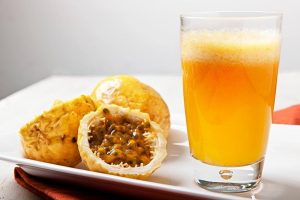By Lindenberg Junior |Translation: Gisele Sweeney
I n Brazil we call it “Maracujá”, and for a while now, it is the “Star” against high sugar levels in the blood and cholesterol. With its origin in tropical regions as Brazil, Costa Rica and Hawaii, the scientific name Passiflora, and generally rounded shape with thick yellowish skin or with orange or green-clear spots coloration according to the species (there are too many, by the way), passion-fruit bears fruit all year around, less intensely during the rain season.
n Brazil we call it “Maracujá”, and for a while now, it is the “Star” against high sugar levels in the blood and cholesterol. With its origin in tropical regions as Brazil, Costa Rica and Hawaii, the scientific name Passiflora, and generally rounded shape with thick yellowish skin or with orange or green-clear spots coloration according to the species (there are too many, by the way), passion-fruit bears fruit all year around, less intensely during the rain season.
The passion flower or passion fruit has been known and used in America before the arrival of the first Europeans who, from the beginning, had been enchanted with its exuberance. With its religious eagerness of conquest, the foreign missionaries noticed in these flowers and fruits much more than only beauty and perfume. The religious ones noticed that the complex and admirable formation was a real gift of God to illuminate their work of catechesis, finding in its shapes and exotic colors the perfect metaphor to explain to the “unfaithful Indians” the truculent history of “Passion of Christ”.
And as a real gift of God and Mother Nature, researchers from the College of Nutrition of the Federal University of Rio De Janeiro (UFRJ) discovered in 2004 its beneficial effect on the reduction of the cholesterol level, on the good functioning of the gastrointestinal system, and particularly on the treatment of diabetes. The secret was in the PECTIN, a fiber that can be found on the skin of the fruit. The power of this neutral substance that acts as adhesive intercellular, holds back the sugars, cholesterol, triglycerides and fats, preventing them from entering totally into the circulatory system. Amongst non-diabetic young and middle-age people, it prevents that the constant alimentary excesses force
the pancreas to an exhausting work. The PECTIN forms a gel in the intestine preventing the absorption of ingested sugars and fats, thus avoiding an overload in the blood. It allows the pancreas to work without excess and prevent the hard work of segregating the substances and regulating insulin of the metabolism of the carbohydrates. Nowadays, the passion fruit is used in almost its totality. From the fruit, you can make a delicious juice, from its leaves you can prepare calming and relaxing tea, and from its skin you can get hydrated flour that contains the fiber PECTIN.
The powerful flour of passion fruit is 100% natural and can be consumed in juices or mixed on top of some meals without removing the original flavor. Soon after its ingestion, you can feel a pleasant sensation of gastric fullness! The skin of passion fruit (white part) in its general composition is rich in Pectin, Niacin (vitamin B3), Iron, Calcium, and phosphorus.
